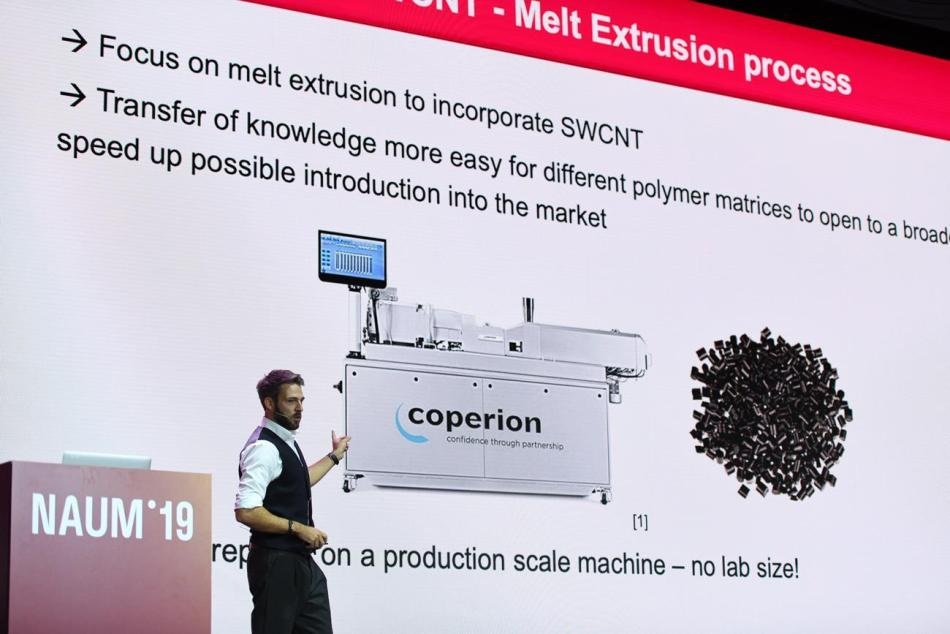Nov 25 2019
At the 2019 Nanoaugmented Materials Industry Summit (NAUM’19) held on November 5–6, experts concurred that graphene nanotubes, also known as single wall carbon nanotubes, are currently the most effective advanced anti-static additives.
 Marco Burth, Lehmann & Voss
Marco Burth, Lehmann & Voss
“TUBALL nanotubes, produced by OCSiAl, appear to have a much stronger effect on the conductivity and very homogeneous dispersion compared with standard carbon black, which demonstrated a number of disadvantages like hot spots,” said Faris Ustamujic, Airbus Defence and Space Senior Engineer. “When carrying out repairs, single wall carbon nanotubes, thanks to their conductivity properties, enable us to create a new life for aircraft components, where the insulating properties of epoxy resins are not allowed. There are no negative effects in wear rate, thermal resistance or bonding strength of the nanotube coating, which is important for us and for our customers,” added Melina Remers from Material Design Engineering at Lufthansa Technik Intercoat.
As stressed by experts, a number of benefits result from the very low loading level of graphene nanotubes that are tens or even hundreds of times lower than those of the nearest analogues. “We were able to replace more then 12 wt.% of multi wall carbon nanotubes in epoxy industrial rollers with just 0.15 wt.% of TUBALL nanotubes, resulting in high efficiency, flexibility in coloring of the final product and a clean production process,” said Michail Nedanov, Project Engineer at SchäferRolls, when sharing some of their recent results, which are now already confirmed with commercial products.
Improving mechanical performance with graphene nanotubes is likely to be the next focus for technological developments. LEHVOSS Group sees a lot of potential in enhancing car bodies with graphene nanotubes, leading to weight reduction. Marco Burth, Product Development Manager, added, “We are scaling up our in situ process polymerization production for PA6 with single wall nanotubes, developing different masterbaches for aerospace, automotive and industrial applications.” Techplast, a European producer of innovative cylinders for breathing apparatus, industry gases and paintball, revealed that, by enhancing composite material with graphene nanotubes, they had been able to decrease the weight of their cylinders by 75% in comparison with conventional cylinders, making their new generation of products the lightest cylinders in the world and widening their application to CNG and hydrogen storage.
Materials should go beyond being stronger to being smarter. Arrival Chief of Materials Rob Thompson shared: “When we talk about vehicle crash performance or embedding sensors into coatings, single wall carbon nanotubes play an important role there. We want to integrate functionalities into the materials without adding processes. And using single wall nanotubes could help us with that.” “We’ve made an aluminum reinforced with nanotubes for a premium OEM,” said Ivica Kolaric, Fraunhofer IPA Head of Department. Furthermore, with single wall carbon nanotubes, Fraunhofer is able to turn more than 16 square meters of car surface into an artificial smart skin for connected cars with sensors and that can change color on demand.
The Japanese companies Nagase ChemteX and Dynic Corporation shared their results in developing transparent conductive films with TUBALL nanotubes. “We investigated most of the types of conductive additives, including graphite and multi wall carbon nanotubes, but we’ve chosen single wall carbon nanotubes as the most suitable solution,” said Shingo Shinohara from Nagase ChemteX. “We believe that these nanotubes can effectively replace expensive ITO in touch panels and solar cells,” added Dynic Chief Developer Ryo Asano.
Graphene nanotubes are finding their way into a growing number of specific applications, for example reducing the radar cross-section (RCS) of wind turbines, where Trelleborg Applied Technologies is using them to prevent interference with airport-approach radar systems. But these tubes are also continuing to be widely adopted as standard in mass-produced applications such as tank lining coatings, powder coatings, conductive primers, flexible foam polyurethane, fast curing cast polyurethane for printing, and flexographic printing; more applications will be added to this list in the coming year.